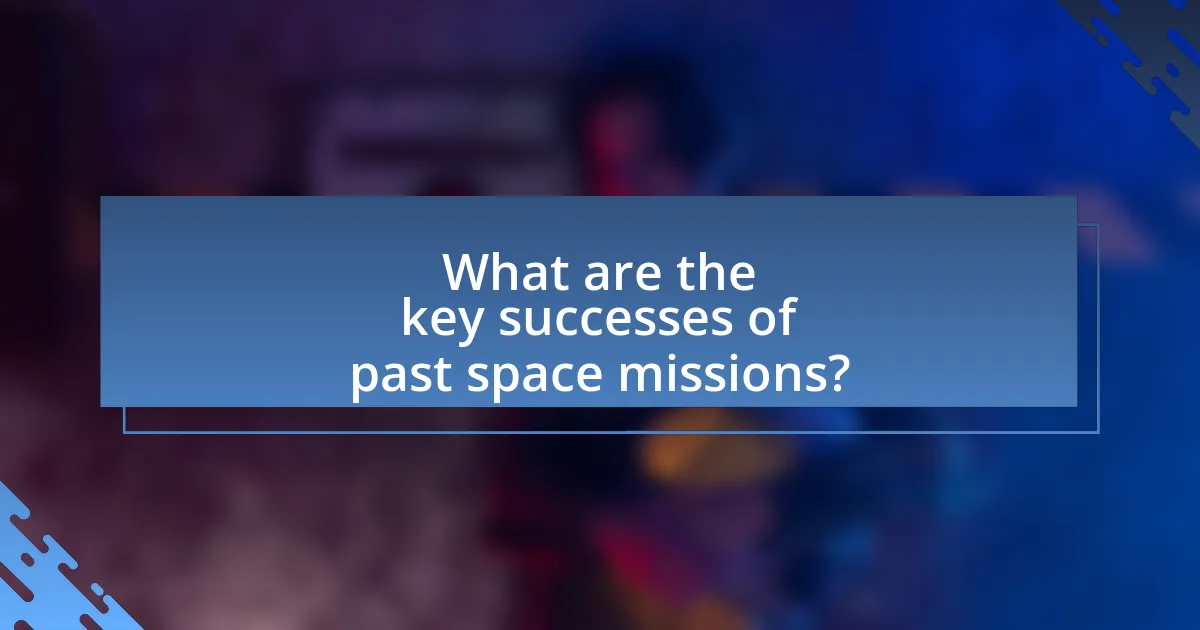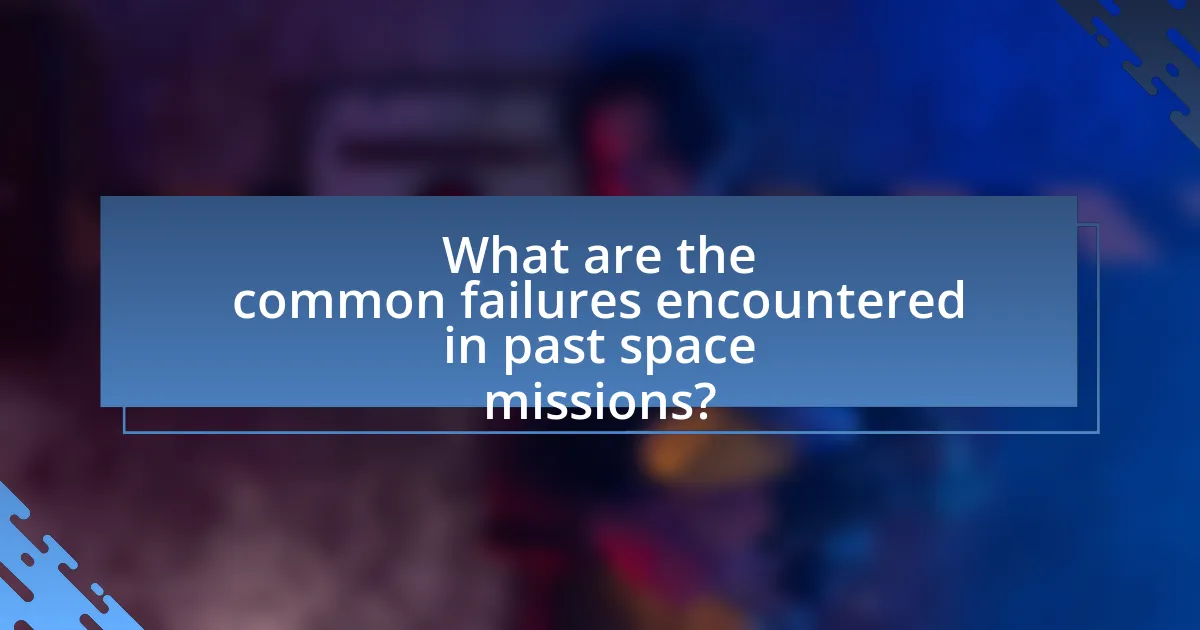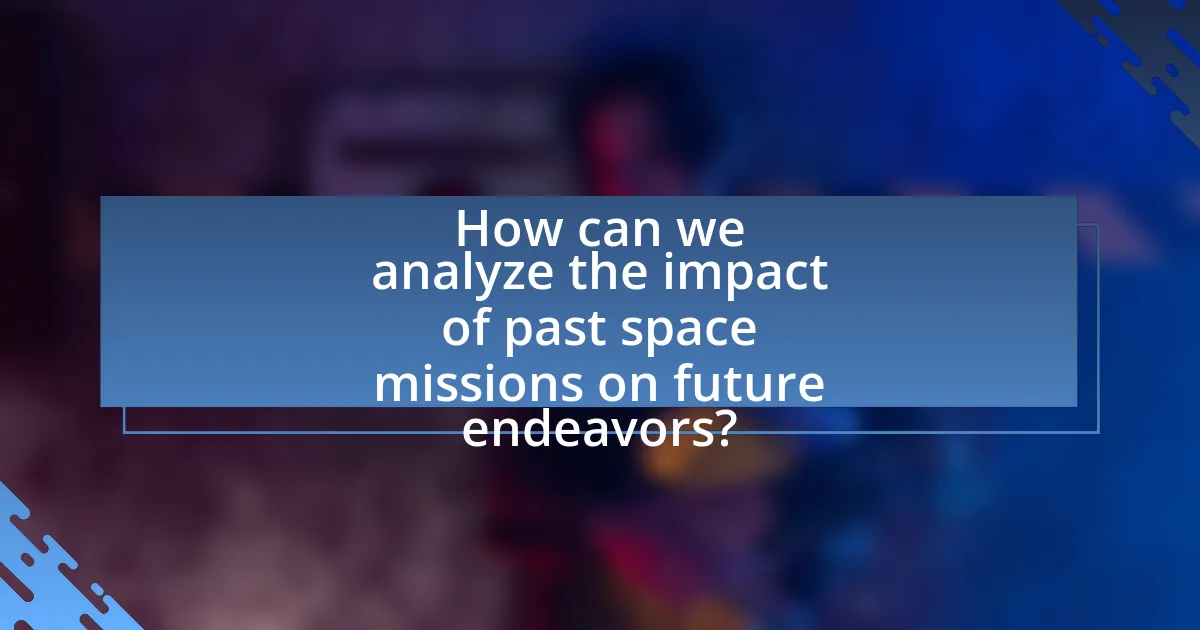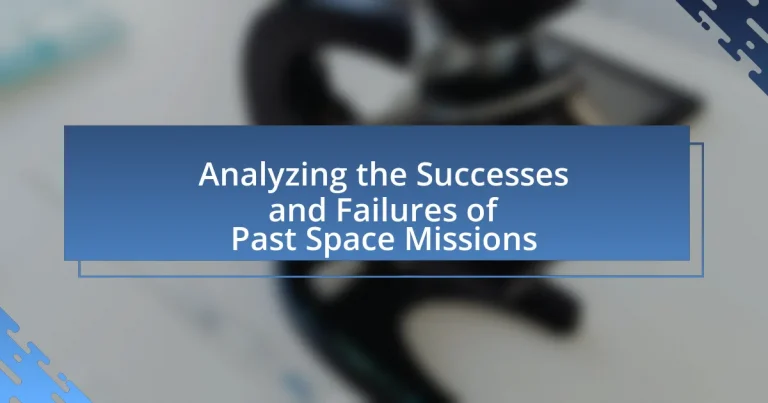The article focuses on analyzing the successes and failures of past space missions, highlighting key achievements such as the Apollo 11 moon landing, Mars Rover missions, and the Hubble Space Telescope. It examines the technological advancements that contributed to these successes, including satellite communication systems and advanced propulsion technologies, as well as the impact of mission planning and execution on outcomes. Additionally, the article discusses common failures encountered in space missions, the factors leading to these failures, and the lessons learned that have shaped future mission designs and protocols. By evaluating both successes and failures, the article aims to derive best practices and strategies for mitigating risks in future space exploration endeavors.

What are the key successes of past space missions?
Key successes of past space missions include the Apollo 11 mission, which successfully landed humans on the Moon in 1969, marking the first time humans set foot on another celestial body. This mission demonstrated advanced engineering and human capability, as astronauts Neil Armstrong and Buzz Aldrin collected lunar samples and conducted experiments. Another significant success is the Mars Rover missions, particularly the Curiosity rover, which landed on Mars in 2012 and has provided invaluable data about the planet’s geology and potential for past life. Additionally, the Hubble Space Telescope, launched in 1990, has revolutionized our understanding of the universe by capturing high-resolution images and providing critical data on cosmic phenomena. These missions exemplify human ingenuity and have expanded our knowledge of space significantly.
How did technological advancements contribute to these successes?
Technological advancements significantly contributed to the successes of past space missions by enhancing capabilities in navigation, communication, and data analysis. For instance, the development of more powerful rockets, such as the Saturn V, enabled missions like Apollo 11 to successfully land humans on the Moon in 1969. Additionally, advancements in computer technology allowed for real-time data processing and improved mission control, exemplified by the use of the Apollo Guidance Computer, which was crucial for trajectory calculations. Furthermore, innovations in materials science led to the creation of lightweight and durable spacecraft, increasing mission efficiency and safety. These advancements collectively facilitated unprecedented exploration and scientific discovery in space.
What specific technologies were pivotal in successful missions?
Specific technologies pivotal in successful space missions include satellite communication systems, advanced propulsion technologies, and autonomous navigation systems. Satellite communication systems, such as NASA’s Tracking and Data Relay Satellite System (TDRSS), enabled real-time data transmission and communication between spacecraft and ground control, crucial for mission success. Advanced propulsion technologies, like the Space Shuttle’s main engines and the ion propulsion systems used in missions like Dawn, provided the necessary thrust and efficiency for reaching and maneuvering in space. Autonomous navigation systems, exemplified by the Mars rovers’ onboard navigation algorithms, allowed for precise landing and movement on extraterrestrial surfaces, significantly contributing to mission achievements.
How did mission planning and execution impact outcomes?
Mission planning and execution significantly influenced the outcomes of space missions by determining their success or failure. Effective mission planning involves detailed analysis of objectives, resource allocation, risk assessment, and contingency strategies, which directly correlate with mission performance. For instance, NASA’s Apollo 11 mission succeeded due to meticulous planning that included extensive simulations and training, ensuring astronauts were well-prepared for various scenarios. Conversely, the Challenger disaster in 1986 exemplifies how inadequate planning and failure to address known risks led to catastrophic outcomes, resulting in the loss of seven crew members. These examples illustrate that thorough mission planning and execution are critical for achieving desired results in space exploration.
What notable achievements have been recognized in space exploration?
Notable achievements in space exploration include the Apollo 11 mission, which successfully landed humans on the Moon in 1969, marking the first time astronauts set foot on another celestial body. This mission, conducted by NASA, involved astronauts Neil Armstrong and Buzz Aldrin, who famously declared, “That’s one small step for [a] man, one giant leap for mankind.” Another significant achievement is the Mars Rover missions, particularly the Curiosity rover, which landed on Mars in 2012 and has provided extensive data about the planet’s geology and climate. Additionally, the Hubble Space Telescope, launched in 1990, has revolutionized our understanding of the universe by capturing high-resolution images of distant galaxies and nebulae, contributing to discoveries such as the acceleration of the universe’s expansion. These achievements are recognized for their profound impact on science and technology, expanding human knowledge and capabilities in space exploration.
Which missions are considered milestones in space history?
The missions considered milestones in space history include Apollo 11, which achieved the first manned moon landing in 1969, and Voyager 1, launched in 1977, which became the first human-made object to enter interstellar space in 2012. Apollo 11’s successful lunar landing marked a significant achievement in human space exploration, demonstrating advanced technology and international collaboration. Voyager 1’s journey provided invaluable data about the outer planets and continues to send information back from beyond our solar system, showcasing the longevity and impact of space missions.
How have these achievements influenced public perception of space exploration?
Achievements in space exploration, such as the Apollo moon landings and Mars rover missions, have significantly enhanced public perception by showcasing human ingenuity and the potential for scientific discovery. These milestones have fostered a sense of national pride and global collaboration, as evidenced by the increased public interest in space-related events, such as the 50th anniversary of the Apollo 11 mission, which attracted millions of viewers worldwide. Furthermore, surveys indicate that public support for space funding and exploration initiatives has risen, with a 2020 Pew Research Center study revealing that 72% of Americans believe space exploration is essential for the future of humanity. This growing enthusiasm reflects a broader recognition of the importance of space exploration in addressing challenges on Earth, such as climate change and technological advancement.

What are the common failures encountered in past space missions?
Common failures encountered in past space missions include technical malfunctions, communication breakdowns, and human errors. For instance, the Mars Climate Orbiter failed due to a navigation error caused by a mix-up between metric and imperial units, leading to its destruction in the Martian atmosphere. Similarly, the Challenger disaster in 1986 resulted from a failure in the O-ring seals, exacerbated by poor weather conditions and inadequate decision-making processes. These examples illustrate that both engineering flaws and organizational issues have historically contributed to mission failures.
What factors typically lead to mission failures?
Factors that typically lead to mission failures include inadequate planning, technical malfunctions, and poor communication. Inadequate planning can result in overlooked risks and insufficient resource allocation, as seen in the Mars Climate Orbiter mission, which failed due to a metric-imperial unit conversion error. Technical malfunctions, such as software bugs or hardware failures, can derail missions, exemplified by the failure of the Ariane 5 rocket in 1996 due to a software error. Poor communication among team members can lead to misunderstandings and misaligned objectives, contributing to mission failures like the Challenger disaster, where communication breakdowns played a critical role.
How do human error and technical malfunctions contribute to failures?
Human error and technical malfunctions significantly contribute to failures in space missions by leading to critical mistakes and system breakdowns. For instance, the Challenger disaster in 1986 was primarily caused by human error in decision-making regarding the launch despite known issues with the O-rings, compounded by technical malfunctions in the rocket’s design. Similarly, the Mars Climate Orbiter failure in 1999 resulted from a unit conversion error, where one team used imperial units while another used metric, leading to the spacecraft’s loss. These examples illustrate that both human oversight and technical deficiencies can create catastrophic outcomes in space exploration.
What role does budget and resource allocation play in mission success or failure?
Budget and resource allocation are critical determinants of mission success or failure in space missions. Adequate funding ensures that necessary technologies, personnel, and materials are available, which directly impacts the mission’s execution and outcomes. For instance, NASA’s Mars Climate Orbiter failed in 1999 due to a budgetary oversight that led to a lack of proper unit conversion, resulting in the loss of the spacecraft. Conversely, the successful allocation of resources in the Apollo program, which had a budget of approximately $25.4 billion (equivalent to over $150 billion today), enabled the successful moon landing in 1969. This illustrates that effective budget management and resource allocation are essential for achieving mission objectives and avoiding costly failures.
What lessons have been learned from these failures?
Failures in past space missions have taught critical lessons about the importance of thorough testing and validation processes. For instance, the Challenger disaster in 1986 highlighted the need for rigorous safety protocols and the dangers of ignoring engineering concerns. Additionally, the Mars Climate Orbiter failure in 1999 underscored the necessity of clear communication and standardization in measurement units, as the mission failed due to a mix-up between metric and imperial units. These examples demonstrate that comprehensive risk assessment and adherence to established protocols are essential for the success of future missions.
How have past failures shaped future mission designs and protocols?
Past failures have significantly influenced future mission designs and protocols by highlighting critical areas for improvement and risk management. For instance, the Challenger disaster in 1986 led to a complete overhaul of NASA’s safety protocols, emphasizing the need for rigorous testing and validation processes before launch. Similarly, the Mars Climate Orbiter failure in 1999, caused by a unit conversion error, prompted NASA to implement stricter engineering standards and cross-checking procedures to ensure unit consistency across teams. These historical events demonstrate that analyzing failures not only informs design modifications but also fosters a culture of safety and accountability in mission planning.
What are the most significant case studies of failure in space missions?
The most significant case studies of failure in space missions include the Challenger disaster, the Columbia disaster, and the Mars Climate Orbiter failure. The Challenger disaster occurred on January 28, 1986, when the Space Shuttle Challenger broke apart 73 seconds into its flight, resulting in the deaths of all seven crew members. This tragedy was attributed to the failure of O-ring seals in cold weather, which led to the explosion. The Columbia disaster happened on February 1, 2003, when the Space Shuttle Columbia disintegrated upon re-entry, killing all seven astronauts on board. The investigation revealed that damage to the shuttle’s thermal protection system, caused by foam insulation falling off during launch, was the primary cause. The Mars Climate Orbiter, launched in 1998, failed to reach Mars due to a navigation error caused by a mix-up between metric and imperial units, resulting in the spacecraft entering the Martian atmosphere at an incorrect angle and disintegrating. These case studies highlight critical failures in engineering, communication, and safety protocols in space exploration.

How can we analyze the impact of past space missions on future endeavors?
To analyze the impact of past space missions on future endeavors, researchers can conduct comprehensive evaluations of mission outcomes, technologies used, and lessons learned. Historical data from missions such as Apollo, Voyager, and Mars rovers provide insights into engineering challenges, scientific discoveries, and operational strategies that inform future mission planning. For instance, the Apollo program’s success in human spaceflight established protocols for crew safety and mission logistics, which are critical for upcoming missions to Mars. Additionally, analyzing failures, such as the Challenger and Columbia disasters, highlights the importance of risk management and safety protocols in mission design. By systematically reviewing these successes and failures, stakeholders can develop best practices and innovative solutions that enhance the effectiveness and safety of future space exploration efforts.
What methodologies are used to evaluate the successes and failures of missions?
Methodologies used to evaluate the successes and failures of missions include qualitative analysis, quantitative metrics, and comparative studies. Qualitative analysis involves examining mission reports, interviews, and case studies to understand the context and decision-making processes that led to outcomes. Quantitative metrics focus on specific performance indicators such as mission objectives achieved, budget adherence, and timeline compliance, providing measurable data for assessment. Comparative studies analyze similar missions to identify patterns and lessons learned, enhancing the understanding of factors contributing to success or failure. These methodologies are validated by historical examples, such as the evaluation of NASA’s Apollo missions, which utilized both qualitative and quantitative assessments to derive insights that informed future space exploration strategies.
How do qualitative and quantitative analyses differ in this context?
Qualitative and quantitative analyses differ in the context of analyzing the successes and failures of past space missions primarily in their approach and the type of data they utilize. Qualitative analysis focuses on subjective assessments, such as interviews, mission reports, and narrative accounts, to understand the experiences and insights of mission participants, which can reveal underlying factors contributing to success or failure. In contrast, quantitative analysis relies on numerical data, such as mission success rates, budget expenditures, and performance metrics, allowing for statistical evaluation and objective comparisons across different missions. This distinction is crucial as qualitative insights can provide context and depth to the numerical findings, while quantitative data can validate or challenge the interpretations drawn from qualitative sources.
What role do historical comparisons play in shaping future missions?
Historical comparisons play a crucial role in shaping future missions by providing insights into past successes and failures, which inform decision-making processes. For instance, analyzing the Apollo missions reveals critical lessons about risk management and technological innovation that can be applied to contemporary space exploration efforts. Additionally, the failures of missions like the Challenger and Columbia disasters underscore the importance of safety protocols and thorough testing, guiding future mission planning to prioritize crew safety. By systematically evaluating these historical events, space agencies can develop more effective strategies, allocate resources wisely, and enhance mission success rates.
What best practices can be derived from analyzing past missions?
Best practices derived from analyzing past missions include thorough documentation of mission objectives, detailed post-mission reviews, and the implementation of iterative design processes. Thorough documentation ensures that all aspects of the mission are recorded, facilitating knowledge transfer and future planning. Detailed post-mission reviews, such as those conducted by NASA after the Apollo missions, highlight successes and failures, allowing teams to learn from mistakes and replicate successful strategies. The iterative design process, exemplified by SpaceX’s approach to rocket development, emphasizes continuous improvement based on feedback and testing results, leading to enhanced reliability and performance in subsequent missions.
How can these practices improve mission planning and execution?
Implementing best practices from past space missions enhances mission planning and execution by providing a framework for risk assessment and resource allocation. Historical analysis reveals that missions like Apollo 13 benefited from rigorous contingency planning, which allowed teams to adapt to unforeseen challenges effectively. Additionally, the use of data-driven decision-making, as seen in the Mars Rover missions, ensures that mission objectives are met efficiently by leveraging real-time data for operational adjustments. These practices lead to improved outcomes, as evidenced by the successful landing of Perseverance on Mars, which utilized lessons learned from previous missions to optimize its trajectory and landing strategy.
What strategies can be implemented to mitigate risks in future missions?
To mitigate risks in future missions, implementing comprehensive risk assessment protocols is essential. These protocols should include thorough pre-mission simulations and scenario planning to identify potential failure points, as evidenced by NASA’s use of Failure Mode and Effects Analysis (FMEA) in the Apollo program, which significantly reduced risks by anticipating issues before they occurred. Additionally, establishing robust communication channels among mission teams can enhance real-time decision-making and problem-solving, as demonstrated during the Mars Rover missions, where continuous data sharing allowed for quick adjustments to unforeseen challenges. Regular training and drills for mission personnel can further prepare teams to respond effectively to emergencies, thereby minimizing risks associated with human error.


